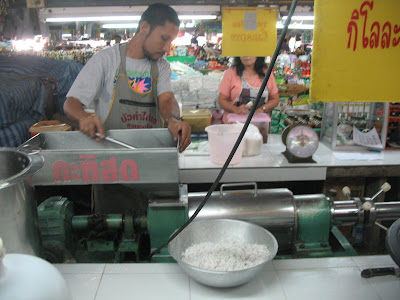Kao Nio Ma Muang
 Mango with Sticky Rice
Mango with Sticky Rice1 cup of steamed sticky rice
1/2 cup of coconut milk
1 ripe mango (peel, remove the seed and slice into pieces)
1-2 tbsp. of sugar (or wet palm sugar, available at specialty stores like Rainbow Grocery)
1/4 tsp. salt
1 vanilla bean (or padang* leaf, if you can get it)
Place coconut milk, vanilla bean, sugar and salt in a pot. Heat until boiling. Turn the heat off. Add steamed sticky rice. Mix together well. Let it cool. Serve with sliced mango.
*Padang is a dark green sturdy leaf that imparts the coconut with a distinct flavor that is similar to vanilla. I don't have a source for it in the U.S., but would be happy to find it someday.
recipe courtesy of The Chiang Mai Thai Farm Cooking School
Do you know how coconut milk is made?...by pressing coconut shavings!
Making coconut milk from shavings at the market
We spent a delicious day at The Chiang Mai Thai Farm Cooking School (www.thaifarmcooking.com), visiting a market in the countryside before touring the school's farm of fresh-as-can-be ingredients, including bananas, mangoes, galangal, ginger, kaffir limes, lemongrass, and more. We cooked a feast with ingredients from the farm, including red curry chicken (kaeng phed gai), basil chicken (phad kaprao gai), pad thai, and chicken coconut soup (tom kaa gai). Are you noticing a pattern? Gai means chicken! We made our curry paste from scratch, but you can see in the photo below that Thai cooks can purchase fresh curry paste in red, yellow, or green from the market in bulk.
 Green curry paste for purchase at the market (thai cooks' secret)
Green curry paste for purchase at the market (thai cooks' secret) Chili sauces and oil at the market
Chili sauces and oil at the market Ladies and gentlemen, I present to you the 20 baht (70 cent) bag of FRESH green peppercorns.
Ladies and gentlemen, I present to you the 20 baht (70 cent) bag of FRESH green peppercorns.That's galangal directly behind the peppercorns.
Sarah and I had these little balls of delight in a very thin sauce with red peppers and lots of broth on our first night in Thailand at a street market stall, served on a skewer of chicken, pineapple, tomato, and onion. Oh how I would love to have access to fresh green peppercorns in California.
In case you're wondering how to make sticky rice...
First, you must purchase sticky rice grains. You can't make sticky rice by using regular rice grains. Next, soak the sticky rice in water overnight. Finally, steam the rice in a bamboo steamer until it is soft. Voila!
We learned a very important lesson at cooking school.
How to eat sticky rice...
1. Grab a ball of the rice with your fingers (half the size of a ping pong ball)
2. Roll the ball in the palm of your hands.
3. Flatten the ball into the shape of a blood cell.
4. Use your patty to scoop up bites of yummy Thai food.
In case you're wondering how to make sticky rice...
First, you must purchase sticky rice grains. You can't make sticky rice by using regular rice grains. Next, soak the sticky rice in water overnight. Finally, steam the rice in a bamboo steamer until it is soft. Voila!
We learned a very important lesson at cooking school.
How to eat sticky rice...
1. Grab a ball of the rice with your fingers (half the size of a ping pong ball)
2. Roll the ball in the palm of your hands.
3. Flatten the ball into the shape of a blood cell.
4. Use your patty to scoop up bites of yummy Thai food.













































